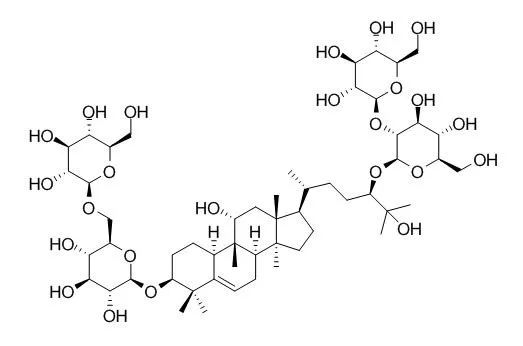| Description: |
Mogrosides IV is a sweet minor cucurbitane glycoside, it exhibits maltase inhibitory effect. Mogroside IV, Mogroside V and combinations thereof act as a Toll -Like Receptor -4 agonist and immune stimulant that can be utilized for both therapeutic vaccine design in cancer and for other pathogenic agents; therapy with Mogroside IV, Mogroside V and combinations thereof are also presented to created immune clearance of a viral infection. |
| Targets: |
LDL | TLR |
| In vitro: |
| J Atheroscler Thromb. 2002;9(2):114-20. | | Sweet elements of Siraitia grosvenori inhibit oxidative modification of low-density lipoprotein.[Pubmed: 12236315] | This study examined the ability of sweet elements extracted from Siraitia grosvenori (SG) to inhibit the oxidation of LDL.
METHODS AND RESULTS:
We monitored the formation of conjugated diene during copper-mediated LDL oxidation in the presence or absence of sweet elements of whole extract of SG (SG extract) or cucurbitane glycosides (CGs) purified from SG extract as sweet elements. CGs consist of Mogroside IV (Mog.IV), Mogroside V (Mog.V), 11-Oxo-mogroside V (11-Oxo-mog.V), and Siamenoside I (Sia.I). In addition, the effect of these elements on human umbilical vein endothelial cell (HUVEC)- mediated LDL oxidation was tested by measuring production of lipid peroxides. SG extract inhibited copper-mediated LDL oxidation in a dose-dependent fashion, but neither glucose nor erythritol suppressed the oxidation. Among CGs, 11-Oxo-mog.V significantly inhibited LDL oxidation, and prolongation of the lag time during LDL oxidation by 11-Oxo-mog.V was dose-dependent. The lag time (119.7 +/- 8.9 min) in the presence of 200 microM 11-Oxo-mog.V was significantly longer than that (76.8 +/- 5.5 min) of control (p < 0.01). In addition, SG extract and 11-Oxo-mog.V inhibited HUVEC-mediated LDL oxidation in a dose-dependent manner.
CONCLUSIONS:
These results demonstrate that SG extract can inhibit LDL oxidation and that 11-Oxo-mog.V, a sweet element of SG extract, provides the anti-oxidative property of SG which might reduce the atherogenic potential of LDL. |
|
| In vivo: |
| J Agric Food Chem. 2005 Apr 20;53(8):2941-6. | | Triterpene glycosides of Siraitia grosvenori inhibit rat intestinal maltase and suppress the rise in blood glucose level after a single oral administration of maltose in rats. [Pubmed: 15826043] | The effect of the crude extract from Siraitia grosvenori Swingle (SG-ex) on the postprandial rise in blood glucose level was investigated.
METHODS AND RESULTS:
The increase in plasma glucose level in response to the oral administration of maltose was significantly suppressed in rats when SG-ex was given orally 3 min before the maltose administration. There was, however, no effect when glucose was administered instead, suggesting that the antihyperglycemic effect of SG-ex is elicited by inhibition of maltase in the small intestinal epithelium. In vitro, SG-ex inhibited rat small intestinal maltase. Similar effects were also observed both in vivo and in vitro when the concentrate of the sweet elements (triterpene glycosides) prepared from SG-ex was used. Furthermore, the main sweet element of SG-ex, mogroside V, and some minor elements such as Mogroside IV, siamenoside I, and mogroside III also exhibited maltase inhibitory effect with IC50 values of 14, 12, 10, and 1.6 mM, respectively.
CONCLUSIONS:
These results suggest that SG-ex exerts anti-hyperglycemic effects in rats by inhibiting maltase activity and that these effects are at least partially exerted by its sweet elements, triterpene glycosides. |
|






 Cell. 2018 Jan 11;172(1-2):249-261.e12. doi: 10.1016/j.cell.2017.12.019.IF=36.216(2019)
Cell. 2018 Jan 11;172(1-2):249-261.e12. doi: 10.1016/j.cell.2017.12.019.IF=36.216(2019) Cell Metab. 2020 Mar 3;31(3):534-548.e5. doi: 10.1016/j.cmet.2020.01.002.IF=22.415(2019)
Cell Metab. 2020 Mar 3;31(3):534-548.e5. doi: 10.1016/j.cmet.2020.01.002.IF=22.415(2019) Mol Cell. 2017 Nov 16;68(4):673-685.e6. doi: 10.1016/j.molcel.2017.10.022.IF=14.548(2019)
Mol Cell. 2017 Nov 16;68(4):673-685.e6. doi: 10.1016/j.molcel.2017.10.022.IF=14.548(2019)